The gift of a new point of view: ChildSightTools®
Posted: August 5, 2021 Filed under: Uncategorized | Tags: aggression, anger, behavior, child, discipline, hitting, not listening, parenting, preschooler, tantrums Leave a comment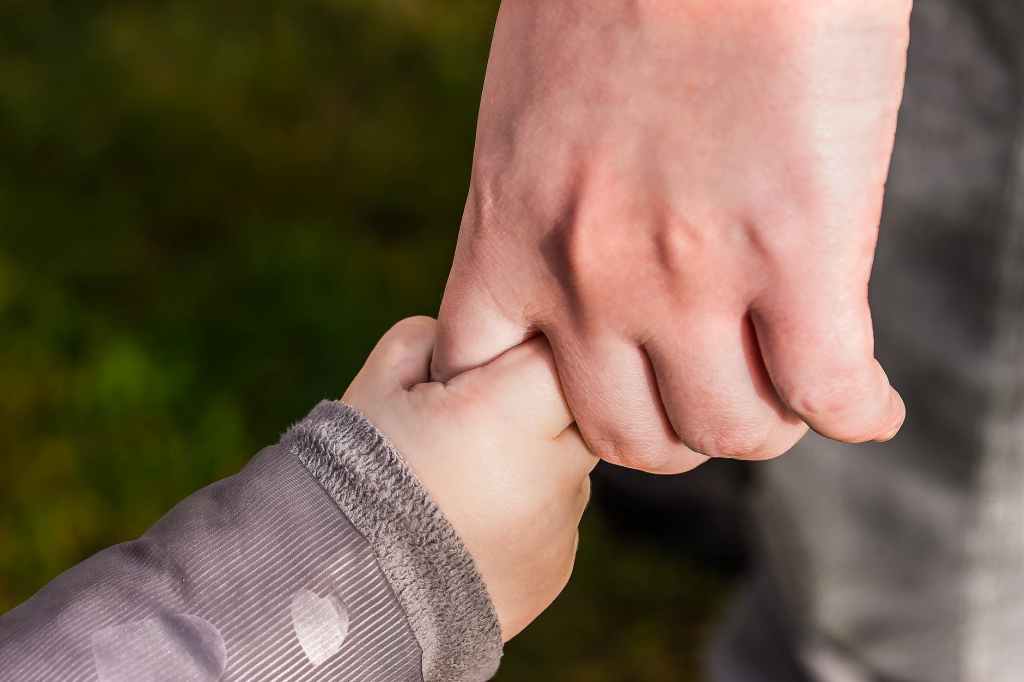
It’s been a while since I posted here in A Child in Mind. Welcome back, those who’ve followed me over the years. And welcome, new readers! Moms, dads, grandparents, nannies, loving relatives. Anyone searching for answers for a young child in their life.

I’ve been busy bringing life to my big goal! To extend my outreach, “help more than one family per hour.” My ChildSightTools® online school has launched! Insights and strategies from 25 years are now in short video segments.
My online courses offer accessible, engaging content. Easy and engaging stuff for busy parents of young kids. Short segments, memes, printables, a digital workbook. Here’s how to have an early childhood psychologist on your phone, tablet, laptop, wherever you are.
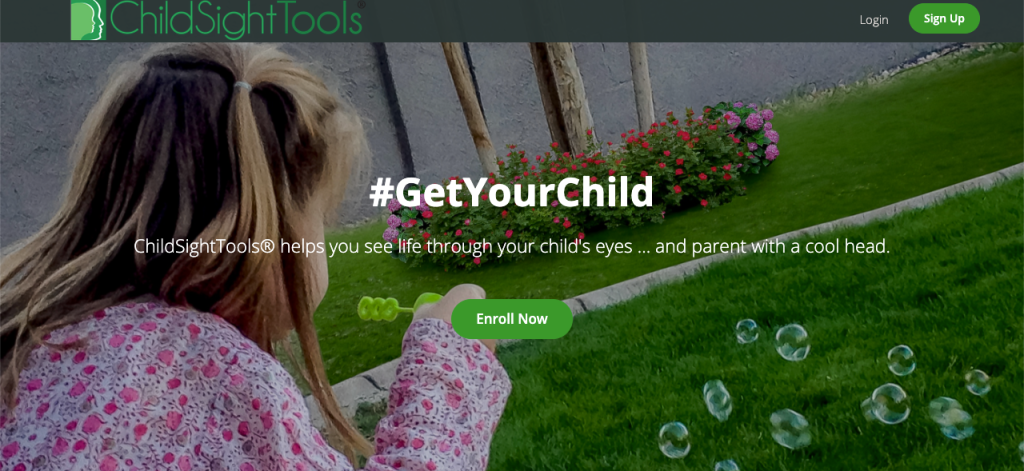
What exactly is ChildSightTools®?
ChildSightTools® is the name of my therapy model as well as my online school.
ChildSightTools® gives parents new lenses and new tools. Parents gain the vision (ChildSight) to see the daily life as your child does … through their eyes. Then parents learn cool-head strategies (Tools) that keep everyone calm and help children cope.
ChildSightTools® is built on this key concept that parents and children taught me:
Looking through your child’s eyes changes everything.
Dr. Beth Onufrak
Remarkable improvements arise. When parents understand their child’s point of view,
- parenting gets so much easier…
- there less strain and strife between adults & kids, and
- home relationships are more loving, joyful, and mutually respectful
So how do we see from the child’s point of view? Young children are so confusing! It’s so hard to grasp why they do what they do! The gap between adulthood and childhood is so vast. We often cannot remember what it felt like to be so young.
But parents like you unveiled the power of trying to see through kids’ eyes. They came to sessions beaming about unexpected progress. Progress came from their own new realizations, from looking more closely at their kids. They formed guesses, hypotheses, possible reasons for the troubles. Guesses like:
- “I’m not sure he’s doing it on purpose … I don’t think he can help it…”
- “Maybe she’s reacting to all OUR stress …”
- “Our work schedule change was harder on him than we thought…“
And they found these guesses to be true. They discovered a new mindset can change what they think, say and do. Big improvements in their child’s behavior went along with their changes.
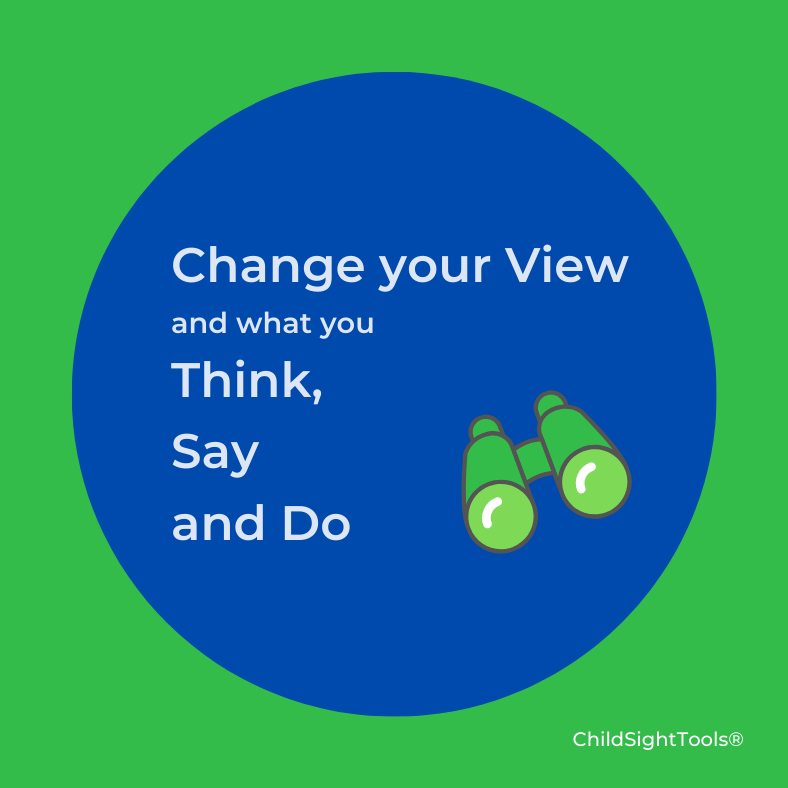
These powerful parent mindset changes were so compelling, I had to call it something. So I named it ChildSight … seeing through the child’s eyes. Which is the total opposite of looking through one’s own adult eyes … which I playfully call “I-sight.”

When we use ChildSight and stead of I-sight, everything changes. Parents change their guesses about children’s abilities; they stop expecting children’s behavior to be logical… they pause and ponder “what does it feel like to be my child?” Which often brings tears to their eyes. Families who spontaneously found ChildSight inspired me to teach other parents how to put on those “glasses.”
How does ChildSightTools® help my child’s behavior?
ChildSightTools® helps child behavior by first helping you, the exhausted parent. In a four-step system, the first step is Uncover the Clues.
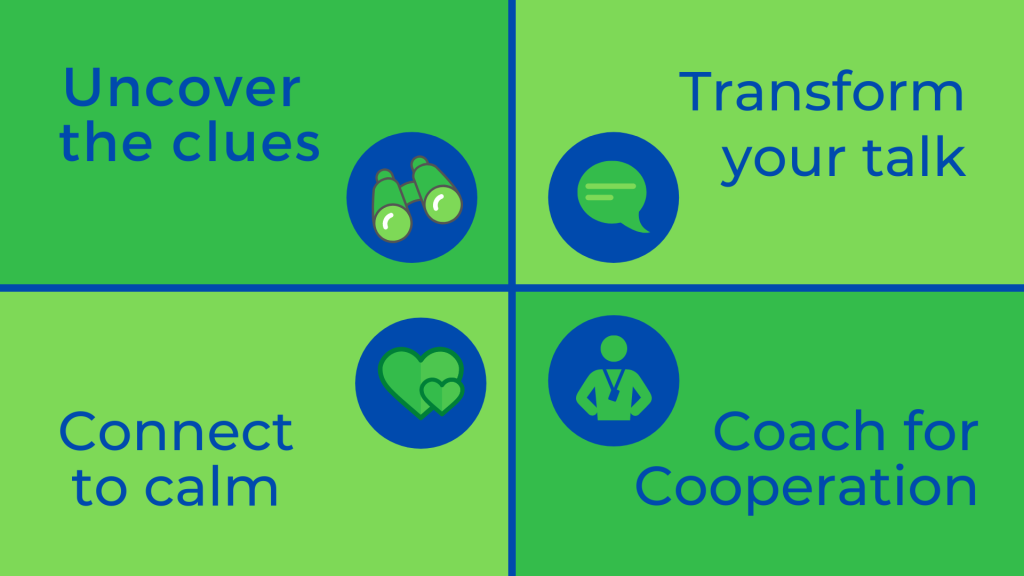
When you Uncover the Clues, you begin to see from your child’s point of view. Then, about a million things change:
- You feel less confused, more understanding
- Your whole body language changes
- You feel less angry, more sympathetic
- Your thoughts change from child-blaming to clue-hunting
- You give fewer consequences and build more bridges
With ChildSightTools®courses, parents discover new mindsets and gather new tools — on their own time. And save the time commitment and investment of therapy. ChildSightTools® doesn’t just get kids to behave. It helps parents “get” their young kids. And that changes everything.

My blog posts used to be “the observation of the week.“ Now they’ll feature elements of ChildSightTools®. Free downloads will help you along your parenting journey with a clearer set of glasses… ChildSightTools glasses.

Welcome on board! I’m so glad to have you with me. Share this blog with other struggling parents who could use a breakthrough. ChildSightTools® not only helps behavior, but helps them enjoy parenting again … or for the first time.
To learn more, visit DrBethKids.com. If you’re feeling burdened and overwhelmed, try my brief, free course. It’s called How to Stay Calm When Your Child is Melting Down in my online school. For a hearty intro to the ChildSightTools system, check out Cool the Tantrums, Feel the Peace.
Photos credit: courtesy of Pixels.com and Canva.
We Thought He Would Grow Out Of It
Posted: July 17, 2019 Filed under: aggression, anger management, Behavior, child therapy, defiance, Development, Emotional self-regulation, Impulse control, Meltdowns, Parenting, Uncategorized | Tags: #momlife #parentingtips #whentogethelp 1 Comment
Sometimes parents wonder if “a little more time” may improve their child’s adjustment, simply through increasing “maturity.” The children with whom I primarily work, preschool and early elementary-age kids, are developing very quickly. So the reasoning is quite valid. With a few more months of time, some problems might evaporate. But this is not always how I see it. Sure — more “development” may make the problem better — or much worse.

Development is like a river. It is moving, and moving quickly. But when a child is struggling, moving further downstream may or not help, depending on what else is poured into that child’s river — that child’s stream of development. Like nurturing, supportive, repairing stuff … or inflammatory, destructive, or plain unhelpful life stuff.
For a struggling child in my care, behavior problems improved over a few months in Kindergarten. However, his parents and teachers added extra things to his “stream.” Therapy offered him new coping strategies. His parents enrolled in my parent workshop. They dedicated energy and effort to learn about their child’s brain and development. Both parents worked on changing their style of interaction with him. His teacher welcomed and implemented new ideas, adopting a positive approach to his classroom behavior.

But for other children, there may be fewer helpful things “in the stream.” Their bodies get bigger and stronger as development progresses. Those changes can result in greater physical conflicts at home and on the playground. Gaps in social skills are more apparent and impactful as months go by, lowering a child’s self-esteem and heightening peer disputes. With progressing development, children become more able to reflect upon themselves and their worlds. And with increasing age, they often draw painful conclusions about their self-worth and abilities relative to others.

As months pass in a struggling child’s development, family tensions may intensify. Unhealthy family dynamics may grow unhealthier still, without the benefit of parent education and support. In this scenario, time can be an enemy rather than an aid.
Yes, for some children, a few months time does make all the difference. But for so many children I meet, delaying helpful services while waiting for developmental maturity only makes problems worse.

For the child who does not simply “grow out of it,” problems may become deeper and harder to remedy. That’s why I work with younger children, when the clay is soft. The younger, the better.
Families arrive and say, “We thought about getting therapy a year ago …” or “I’ve had your card in my purse for two years.” Don’t put it off … check out your concerns early in development. And find an early childhood specialist who understands that young children are not just smaller versions big kids. Don’t just wait for growth … help it along.
______________________________________________________________________________
Dr. Onufrak is the developer of ChildSightTools® parent programming. Visit DrBethKids.com for more information and resources. Look for my Online Parent Courses coming soon. Get my free booklet Chill Your Child’s Anger on my homepage. My Weekly 2-Minute Tip videos can be found on my homepage and on YouTube.
Mommy, my brain is hungry!
Posted: May 23, 2016 Filed under: aggression, anger management, brain development, child psychology, child therapy, Discipline, Emotional self-regulation, Impulse control, Meltdowns, Parenting, Uncategorized 1 Comment
Young kids tell you what they want. The iPad. Angry Birds. Skylanders and Lego Ninjago. American girl dolls and My Little Ponies. A pop tart. A fruit rollup. Goldfish. Noodles with butter. Sound familiar?
If only they knew what their brains wanted … to help regulate their physical and emotional states. Their pleas might then sound like this: “Mommy, my brain is hungry! I gotta have some protein to focus. I need some avocado to think of something else before I hit my brother!”
The brain/nutrition link is elementary. The brain runs on neurotransmitters. Neurotransmitters are made from food, specifically protein. Neurotransmitters are carried on the superhighways between cells that are coated with fat. [Fat, you say? Good fats.] And sugars provide glucose for brain energy. Complex carbohydrates supply sustained, long-lasting energy; simple, quick burning carbs only give rapid, short-lasting energy, leading to “zoom and crash.”
A parent might as well say,
“Blood sugar, go to your room!”
An after-school tantrum can reflect low blood sugar. Classroom distraction can reflect inadequate intake of quality protein. Poor impulse control can reflect deficiencies and DHA and EPA. I am no longer content to blame behavioral problems on “psychological” issues when the body may be the problem, or at least part of it. How silly that distinction even sounds… the distinction between mind and body is history.
Parents bring kids to psychologists to help change how their minds work … when it’s children’s bodies that often get them into trouble. The unspoken assumption is that the child mind can control his body, given the proper “tools.” But it’s more and more clear to me ~ we often have to help the body and brain first before I can do much with the mind.
Nothing is more proximal to your child ~ closer to his interior being ~ than what’s in his cells at any given moment.
… closer than your hug, your touch, your loving words or threatened punishment … closer than therapy interventions.

Knowing children’s brains are hungry, I now routinely recommend a nutritional consultation at the commencement of care. Sometimes, I advise parents at the intake to return in 30 days after implementing nutritional changes. No longer can I accept parents’ money and take their time if I believe a child’s body needs help before her mind can respond. How would I know this?
Over the past 4 years of my practice, my referrals for child psychiatry consults have plummeted. Why? Because parents are trying nutrition first with profound results. Many kids accept new food routines and even request specific foods at key times. They quickly recognize how different ~ and better ~ they feel. These children actually start to say, “Mom, I need some protein…” My colleague Jan Katzen, former Montessori teacher and Certified Nutritionist, often says, “I have yet to meet a brain that does not respond to better nutrition.” Jan is one of my most valued referral sources. Learn more about her at http://www.NutritionforLearning.com.
Do I lose business with all my nutrition referrals? Sort of! Some kids improve by eating differently and no longer need my services. But more often, kids come back after a nutritional boost. Then therapy is more efficient and effective. That’s because a child’s brain chemistry and blood sugar is working with me.
Findable, affordable foods could potentially transform your child’s brain and body from dysregulation to balance. Changing the timing and composition of snacks and meals can make all the difference. Canned black beans, apples with almond butter, stone-ground tortillas, walnuts and cage free eggs can turn around brains and behavior. Not being a nutritionist, I’ll stop there and leave it to the experts. Picky eater? Nutritionists of often have sneaky ideas for helping gradually change your child’s palate.
Does changing your child’s diet take some time and money? Yes. So does therapy. Try one, and you may not need the other.
The Summer Before Kindergarten
Posted: June 30, 2015 Filed under: Baby talk, Child-Sight, Meltdowns, Parenting, Regression, school, summer Leave a comment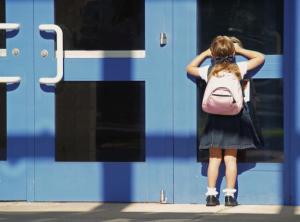 Your child is “so excited” to start Kindergarten ~ so what’s with this clinginess, baby talk and tantrums of the past?
Your child is “so excited” to start Kindergarten ~ so what’s with this clinginess, baby talk and tantrums of the past?
“He visited his new school and totally LOVES it.”
“She’s really trying to read!
“He CANNOT WAIT to go to big-kid school.”
With evidence like that, no wonder you are shaking your head. What are these sudden, summer tantrums over “nothing?” Clinginess like two-year old days? Baby talk that’s driving you bananas?
Your child could be feeling ambivalence about kindergarten. Let’s get our magic 8 ball. Your child’s predominant statements may indicate “signs point to yes.” But your child’s regressive behavior may invite you to “concentrate and ask again.”
Ever had two feelings at the same time? Of course you have ~ it’s part of the human emotional condition. Love to go on vacation, dread the long drive. Want that new phone, but ugh, the learning curve. How easy it is for us, however, to forget this basic tenet when it comes to kids. Children can have more than one feeling at a time. But they don’t know this fact and are confused by multiple feelings themselves. Their mouths may say one thing, but their bodies act out another. Everyone is confused.
For every independence striving, there is anxiety.
“I want to … but will I be able  to?” The little 5-year-old, having left the familiar safe rooms of a preschool she’s attended for up to three years, is indeed excited. And scared to death. The thought of the new grade can feel as intimidating as towering university columns.
to?” The little 5-year-old, having left the familiar safe rooms of a preschool she’s attended for up to three years, is indeed excited. And scared to death. The thought of the new grade can feel as intimidating as towering university columns.
Just because he saw the campus and classroom, adores his new teacher and has a couple of good buddies there … change is hard. And young ones do not have a long remember-able history of managing changes that turned out okay.
“Kindergarten-me” was terrified about grown-up words. Adults read me engaging storybooks featuring a recurring word: “particularly.” Spoken with eloquence and inflection. Made me shiver. How in the world would I ever be able to pronounce that word? Growing up clearly required it. Maybe staying little was the answer. “Beth, pay attention,” said the teacher, unaware of my paralyzing angst. Your little one could be harboring silent worries like this. Memories such as these flowered my path to becoming a child psychologist.
So, how to manage regressive behavior in the summer before Kindergarten?
-
Park your logical brain. It will only stall your efforts to look through your child’s eyes. One feeling stated is one feeling stated. There can be additional feelings too, that are contradictory.
-
Take a little walk back in time. How did YOU feel the summer high school ended? No matter what your plans ~ college, work, or “no idea” ~ you likely had nostalgia for the place and life-stage you were leaving, and anxiety about what lay ahead.
-
Think to yourself: Ending preschool is like being a senior ... looking ahead to the future. Seeing the younger students, feeling older, knowing you are leaving. Heck, we give preschoolers caps and tassels now in in mock graduation ceremonies. Not so make-believe.
-
Notice and ask: Talk to your child ~ “I know you’re feeling excited about Kindergarten. Do you know people can have more than one feeling at the same time? I wonder what other feelings you might have.” Validate and accept the feelings – don’t dismiss or whisk them away. Normalize and give reassurance that adults will be there to help, every step of the way.
-
Draw a feelings heart. Get a bunch of markers, outline a heart, and color it in with patches of color ~ each representing a feeling and its relative momentary “size.” Draw your own heart first, choosing colors to stand for feelings you have right now: tired, sad, excited, worried. Invite your child to draw his or her own. Don’t worry about percentages or doubles (same feeling represented twice) ~ rather than a pie chart, it’s a feelings-identification exercise.
“Child-Sight” can help you through this developmental transition. Child-Sight is a process I teach parents ~ to look through their child’s eyes, informed by child development secrets and brain function facts. Simply recognizing your child may have multiple feelings about Kindergarten is the beginning of Child-Sight. It’s an eye-opening pair of glasses that helps you change your view and what you think, say & do.
Try using Child-Sight on your ambivalent Kindergartener! Watch the regressive behaviors fade away as they begin to step into the Big Kid Shoes at their feet.
_______________________________________________________
The Child-Sight Treatment Model is Dr. Onufrak’s integrated program of child therapy, blending cognitive-behavioral play therapy with her Parent Toolbox of strategic support solutions.
A Radio Show … For Real
Posted: November 25, 2014 Filed under: child psychology, child therapy, Parenting, Play Therapy | Tags: behavior, child behavior, child development, child psychology, discipline, meltdowns, parenting, Play therapy, radio Leave a commentPretending to host a radio show is my favorite Play Therapy technique. And now I have the chance to do it for real.
 It started in 1970 with my father’s reel-to-reel tape recorder. The thrill of that device was intoxicating and addictive … surpassing by far the allure of any toy. From the living room floor, I’d “broadcast” countless hours of shows. Commenting upon momentary whims, meditating on the arrival of my grandparents, singing self-authored songs, interviewing family members. Beseeching my grandfather to record a bedtime story, preserved for posterity.
It started in 1970 with my father’s reel-to-reel tape recorder. The thrill of that device was intoxicating and addictive … surpassing by far the allure of any toy. From the living room floor, I’d “broadcast” countless hours of shows. Commenting upon momentary whims, meditating on the arrival of my grandparents, singing self-authored songs, interviewing family members. Beseeching my grandfather to record a bedtime story, preserved for posterity.
And along the way I grew up, preserving detailed recollections of my development ~ emotional, social, physical and cognitive. Those recollections keep me close to the child mind, fostering insights that assist me today as a Clinical Child Psychologist and Play Therapist.
A Play Therapist must be a flexible, creative creature with a diverse collection of tools. The top of one’s head is often a rich source of inspiration. And one day, from that very location, an idea struck me ~ an impulse rooted in my own childhood play.
A reticent sensitive young boy on the Autistic spectrum was having a hard time settling into in therapy. Until I handed him a microphone.
 It was not a real microphone – but it was real enough to him. He took the wooden ruler in his hand and began to disclose the observations of his mind and yearnings of his heart to an imaginary audience. “Callers” ~ kids and adults, in as many accents as I could devise ~ requested his sage advice. The “Dr. Beth Show” became our therapy modality as I witnessed his coping efforts advance with grace and confidence. “The Show” became a dependable play therapy tool which has helped many child clients since.
It was not a real microphone – but it was real enough to him. He took the wooden ruler in his hand and began to disclose the observations of his mind and yearnings of his heart to an imaginary audience. “Callers” ~ kids and adults, in as many accents as I could devise ~ requested his sage advice. The “Dr. Beth Show” became our therapy modality as I witnessed his coping efforts advance with grace and confidence. “The Show” became a dependable play therapy tool which has helped many child clients since.
So, when the VoiceAmerica.com Talk Tadio Network contacted me, I was incapacitated by laughter. Soon thereafter, incredulity morphed into musings ~ and musings into a clear vision. I began to imagine a child psychology program that could inform and support parents of young children wherever they are. With delight, I accepted invitation to host a weekly radio show.
Child Psych Central: Discover the KidBrain will launch December 11th at 10AM PST on VoiceAmerica.com.
The show will feature my discussions with child mental health experts, local, national and international. We’ll cover issues that cross my desk weekly in my clinical practice. My guests and I will explore early childhood conditions, issues and services to inform parents in an in-depth, accessible way. I will ask my expert guests questions I believe parents would ask if they were in studio with me.
Find it on the Health & Wellness channel. Podcasts will be available on iTunes and social media outlets. My Facebook and Twitter feed will feature guests and links to every episode. This blog will also feature guests and show topics to help you find resources for your family.
Please join me for the launch of Child Psych Central: Discover the KidBrain! Catch it on December 11th at 10AM Pacific on VoiceAmerica.com. Pretending was great fun – but I know this will be even more. Hearty thanks to my colleagues, friends and client families for their advance support. Tune in – this time, for real!
Girls’ Friendship Help to the Rescue!
Posted: October 15, 2014 Filed under: aggression, Development, Emotional self-regulation, friendships, Parenting, Relationship, school 6 CommentsWhat is it about girls and their friendships? Feelings get caught up in the mix. Girls who yearn for good social connections find themselves wrapped up in painful drama. Driven by their raw hurt feelings, girls often make retorts that worsen problems and intensify conflict. Parents try to help but don’t always have the most useful suggestions. “Just ignore her” or “just stay away from her” doesn’t cut the cake. How do we teach girls healthy communication skills? How can we help them express feelings assertively as well as develop compassion for others?
The best answers I have ever found reside in Annie Fox’s brand new book, The Girls’ Q&A Book on Friendship. Annie Fox, M.Ed., is an internationally respected parenting expert, family coach and trusted online adviser for teens. But in this book she aims younger — to girls in third through sixth grades, ages 8-12. Annie Fox hopes to arm young girls with constructive, healthy friendship tools before the perilous middle school years. The delightful illustrations are by the talented Erica De Chavez. I love Annie’s vision of parents and girls cuddling up together with this book in their lap.
In my early childhood private practice, I see many girls in 3rd grade in addition to those who return at an older stage of development. For a long time, I’ve been yearning for such a book as this. And here it is! For my first guest blog, Annie Fox agreed to answer some questions of mine to introduce this book to my readers … for help today, or for tomorrow!
Dr. Beth’s Interview with Annie Fox
Q: Dr. Beth – Why do you think girls become “mean?“
A: Annie – If there can be a short answer to that HUGE question, it may be that “meanness” is a cover for hurt, jealousy, frustration, feelings of rejection, etc. And of course, girls aren’t the only ones who experience those emotions! Without getting too philosophical, I believe we live in a culture of cruelty where it is more acceptable to express aggression than it is to express vulnerable emotions. Maybe that’s why many girls and boys, men and women find it “easier” to respond to hurt, etc. with meanness. It’s ironic, when you really think about it, because when we feel vulnerable (and insecure in a relationship or in our social standing within a group) what we really want and need is reassurance. We want to bring people closer to us. Being mean isn’t likely to get us what we really want, and yet, that’s the behavior many choose.
Q: Dr. Beth – What led you to create the Q&A Guide in this format?
A: Annie – I’ve been answering email from tweens and teens since 1997. They send me questions about everything you can imagine (and lots of things you probably can’t imagine! LOL). And I often ask them questions too. So the question and answer format has become a very natural way for me to teach kids about empathy, compassion, social courage, and the difference between real friends and the other kind. Like any good teacher, my goal is to get kids to think for themselves … hopefully to help them learn how to calm down and ask themselves some questions before they respond to sticky situations. Questions like: “What am a going after in this situation?” and “Can I really change someone else’s behavior?” “And if I can’t get someone to change, how can I change my own response to what’s going on?”
Q: Dr Beth – What are the main messages you hope to promote in the Q&A Girls Friendship Guide?
A: Annie – My main messages are:
1. You have the right to choose your friends, but you never have the right to be rude or disrespectful to anyone.
2. When we’re upset we don’t think clearly and we’re more likely to do or say things we will later regret. Calming down is the best first step to resolve any friendship challenge.
3. Sometimes we need to “take a vacation” from the drama! When you take that break you give yourself time to regroup and figure out what you really want and need in a friendship. You may discover that what you want and need can be found with a new friend.
Q: Dr. Beth – Parents often don’t see girl troubles coming until it hits their daughter. Why might this be?
A: Annie – Some girls (and boys) assume that when they get to a certain age they should not be sharing their emotional upsets with their parents. They figure “I’m old enough to take care of this myself.” And sometimes they can! But other times, kids start to feel overwhelmed by what’s going on in a friendship or some other peer relationship. The emotions are so intense they may not know how to talk about them to parents or anyone! (That’s when they write to me.)
In some cases, a girl is having trouble with a long-time friend (and her parents are long-time friends with the other girl’s parents). In those scenarios, the girls find it really hard to accept that there is a problem. (“How can there be a problem when we’ve been bff’s since pre-school!?”) And when they do talk to parents, the advice they get isn’t so helpful. (“Oh, she was probably just having a bad day. Forget about it.”) Parents need to know just how important their daughter’s friendships can be. By paying attention to the signs that a girl is feeling upset, a parent can help a girl express her feelings and brainstorm some options for her next best move. I’m hoping that parents/grandparents, teachers and counselors will read the book and use it to help girls.
Q: Dr. Beth – Your book is for 3rd to 6th graders. But what are your thoughts on 1st & 2nd grade girls? What early messages should they receive to build a foundation for healthy friendships as they grow?”
A: Annie: I know that girls’ friendship challenges can begin as early as preschool. My book could be used very effectively with K-2nd graders as girls that age are likely to recognize the situations in the book’s Q&A. This book is designed to give girls (and the adults who care about them) tools for managing emotions, communicating more effectively, and recognizing that when it comes to friends, it’s important to have some clear standards about what makes a real friend. And it’s very important that girls of all ages recognize that a friendship is a 2-way street. Yes, we want a friend to be kind, fun to be with, generous, a good listener, etc. And we also need to be aware of the kind of friend we are to others as well!
You can visit Annie at AnnieFox.com. Look for The Girls’ Q&A Book on Friendship at Amazon.com, where you will also find my review. I know this book will be of help to many girls in my care – for now, and in the years to come.
10 Tips for A Great Parent-Teacher Partnership
Posted: August 6, 2014 Filed under: parent-teacher, problem solving, school, teachers | Tags: parent-teacher conferences, school, teachers 1 CommentIn a typical school year, I witness the full range of parent-teacher relationships …
from strong, respectful partnerships with regular and excellent communication … to volleys of accusatory emails, bitter meetings, and rehearsal of stinging remarks. And I don’t even work in a school! Families often consult outside mental health providers for support and assistance. But it is extremely difficult to help a struggling student when parent-teacher strains are sky-high. By the time a family meets me, mutual bitterness and hostility may be ingrained on both sides.
My hopeful mind is full of wishes this week as Valley of the Sun kids return to school.
I’m wishing parents can commit to constructive engagement strategies that create resilient, respectful and prosperous parent-teacher relationships. The suggestions below don’t replace advice from a special education advocate, who may be needed in some situations. But even when serious issues require advocacy, the following ideas may prevent a flame from becoming a blaze along the way.
Below are practices of parents who successfully navigate parent-teacher tensions … and the advice for which I am thanked most often. By mid year, it can be very hard to implement these suggestions. So, I offer them now.
Thank your child’s teacher. Yes, even in the first days of school. Just thank him or her for playing this important role in your child’s life — and for the work you know they’ll be putting in this year. Few among us are equipped to handle 25 or more children all day, every day, attending to each. Begin the year by expressing appreciation and gratitude. In essence, pay it forward.
O ffer to begin a parent/teacher journal. Make your entries in a positive constructive fashion. It may help your teacher very much to know that it took 90 minutes to do two pages of math, and that the 16-year-old cat is ailing and the kids were up late Sunday night with visiting cousins.
ffer to begin a parent/teacher journal. Make your entries in a positive constructive fashion. It may help your teacher very much to know that it took 90 minutes to do two pages of math, and that the 16-year-old cat is ailing and the kids were up late Sunday night with visiting cousins.
Raise concerns in a collaborative fashion. Note what you observe in a non-blaming manner. Assume you may not have all the facts. Ask how you and teacher may problem-solve this issue together. That will take you miles farther than the blame game. Remember too – you never know what a teacher is going through personally. Last school year alone, teachers of kids in my care persevered in the classroom through breast cancer, miscarriage and family bereavement. Kindness first, kindness first …
 Share positive, tender, little known things about your child. A child who struggles with learning and behavior in the classroom may not display his or her most endearing qualities to the teacher. Share these little qualities, sayings, and drawings by your child to soften a teacher’s heart if you sense tensions.
Share positive, tender, little known things about your child. A child who struggles with learning and behavior in the classroom may not display his or her most endearing qualities to the teacher. Share these little qualities, sayings, and drawings by your child to soften a teacher’s heart if you sense tensions.
Divorced? Communicate with your ex about school. Don’t make the school ground another battlefield. Teachers caught in the cross-fire cannot help their students. Check out creative online solutions like ModernFamilySolutions.com. They offer divorced parents a vehicle for staying in the same page about family schedules and information that’s important to share. I DO know this is easier said than done … but no less essential for your child’s school year and overall adjustment.
 Ask for information rather than accusing. “Missing factoids” are the difference between war and peace. No matter how furious you feel or how wronged you believe your child to be, approach the situation in a fact-gathering mode. A teacher is just another human… and most humans defend when they feel attacked. Try statements such as “I understand x-y-z happened… I’d like to learn more about what happened so I can help my daughter. What else can you tell me? Can we arrange a mutually convenient time to talk?”
Ask for information rather than accusing. “Missing factoids” are the difference between war and peace. No matter how furious you feel or how wronged you believe your child to be, approach the situation in a fact-gathering mode. A teacher is just another human… and most humans defend when they feel attacked. Try statements such as “I understand x-y-z happened… I’d like to learn more about what happened so I can help my daughter. What else can you tell me? Can we arrange a mutually convenient time to talk?”
Kindly request positive feedback if a teacher reports predominantly negative things. Be respectfully honest. You can say that problem reports are essential so you can help your child, but that it’s difficult to hear only about troubles. Say that you need to know positive things as well to keep your child encouraged. If you don’t think you can convey this calmly in person, do it in writing.
 Wait til after pick-up time to raise sticky concerns. Complaining to the teacher in front of your child undermines your teacher’s credibility. This is the person you want teach your child tomorrow –with a happy heart –all day long. Respect goes farther than righteousness. You may be completely in the right … but I have never heard of a productive teacher confrontation in the presence of a young student.
Wait til after pick-up time to raise sticky concerns. Complaining to the teacher in front of your child undermines your teacher’s credibility. This is the person you want teach your child tomorrow –with a happy heart –all day long. Respect goes farther than righteousness. You may be completely in the right … but I have never heard of a productive teacher confrontation in the presence of a young student.
Offer to help in the classroom or contribute however you can. If you are a working-at-home parent or part-time employee, consider volunteering some classroom hours. If you’re a full-time employee, ask the teacher how you might contribute during non-classroom time.
 Thank your child’s teacher. Already did that? Do it again. And again. Thank him or her for effort, patience and listening. Even if gratitude is not the number #1 emotion you feel, it’s the most important one to express.
Thank your child’s teacher. Already did that? Do it again. And again. Thank him or her for effort, patience and listening. Even if gratitude is not the number #1 emotion you feel, it’s the most important one to express.
This advice is not so easy to apply mid-year if tensions have flourished for months. Try these tips early on! Intentionally cultivate a collaborative parent-teacher relationship. You and your child may have a much better school year.
What Every Parent Wants
Posted: July 30, 2014 Filed under: anger management, Behavior, child therapy, Discipline, Emotional self-regulation, parent workshops, parent-child relationship, Parenting, Therapy | Tags: behavior, child behavior, child development, child psychology, discipline, meltdowns, parenting, tantrums 3 Comments
Parents want lots of things for their kids.
But when they call me, there is astounding similarity in what they want. Parents arrive, hope in hand. They sit on my couch and describe children of different ages, issues, gender, and problem settings. Yet every parent wants the same thing. Improbable, but true. How can this be?
CONNECT
Parents yearn for their young children to connect better — with them at home, and with others outside the home. They pray for smoother interactions between their child and other kids, between their child and other adults. They wish their child could …
Get through a play date without a knock down/drag out, friend-goes-home-early;
Feel brave enough to say hello on the playground;
Handle teacher correction without feeling she’s “mean;”
Be able to tell a teacher what one feels and needs;
Have as many loving moments at home as challenging ones;
Enjoy mutually satisfying parent-child interactions.
COPE
What else do they want? Without exception, every parent who comes to my office wants “coping skills for my child.” After many years, I noticed this word mentioned in EVERY intake — not just many or most. Parents yearn for their child to acquire skills that can be remembered, applied and activated in troubling times. For their children to learn to handle a situation without aggression, withdrawal, meltdown, a freak out, or “bad choices.”
THRIVE
My new patient paperwork concludes with this question:
“Say you run into someone six months from now, someone who knows your family well but hasn’t seen you in a while. Somehow, things have gotten better. What would you like to be able to say?”
In the hopeful answers to this question, the same word keeps cropping up: THRIVE. “He is just thriving” or “She’s thriving now in every way …” Parents want their child to feel success, joy, light, achievement and resilient self-esteem – to thrive on every level of development.
So, parents want their children to connect and cope better, so ultimately they can thrive. Over my 20 years as a child psychologist, I see those aspirations as intertwined. But perhaps not as you’d expect.
With preschool & primary graders,
child coping is a joint venture between adult & child.
They learn and practice these skills with YOU
and apply them in the world.
Wait … don’t kids learn to cope in the therapy room?
They learn it in every room. Young children are developing their “coping systems” – a complex blend of neurological, physiological and emotional and social mechanisms for reacting and responding to challenge. Part temperament and genetics, part modeling, part impulse control, part emotional regulation. A tall order for the young ones I see. Very hard to do alone. We adults actually help or hinder children’s coping through our interactions with them.
Adult-child interactions literally build kids’ brains, fortifying the neural groundwork for either calm, confident problem solving or alarmist, defensive/offensive or escapist problem solving. What’s the difference? Asking for help versus throwing a chair; greeting an unfamiliar child versus hiding behind your leg; expressing the thought “This is too hard” versus running out of the classroom.
To help children connect, cope & thrive,
I teach adults to facilitate their child’s coping
through brain-building interactions styles.
At some point in the process of child therapy most parents mention to me, “It kind of seems like you’re training us …” Down the road, many parents also share a common disclosure, admitting somewhat sheepishly but with deep pride: “I noticed he really started to change when I started to change. I had no idea ….”
Child therapy is composed of direct child intervention AND parent guidance. Parent workshops go straight to parent guidance. Workshops pump parents full of information that lower the temperature of child problems.
For instance, parents learn why yelling never works. We think the louder we yell, the more kids will remember the lesson next time. Right? Wrong. Yelling activates the threat center in the limbic system in the brain, taking blood and oxygen away from the thinking cortex. Yelling literally incapacitates the child’s cortex from problem solving. Thinking goes off line. Good coping doesn’t get rolling like that.
You can learn to help your child Connect, Cope & Thrive via child therapy or a parent workshop. Or, you try to apply these few concepts and see if things improve:
Child coping starts at home in every interaction you share.
Your own calm coping is the best model for your child’s coping.
If your child’s “upset elevator” goes up, keep yours down.
Promote your child’s coping through calm connection that models the cool you want them to achieve. Remember, you are building his or her brain in these early years. Parents are the most important part of child therapy.
Dr. Beth’s Parent Workshops & Saturday Seminars resume September 2014 including: Savvy Solutions for Your Challenging Young Child; You & Your Anxious Child; and The Child-Sight Model: Change Your View and What You Think, Say and Do. Visit DrBethKids.com for details. Photo credit: by Beth Onufrak








